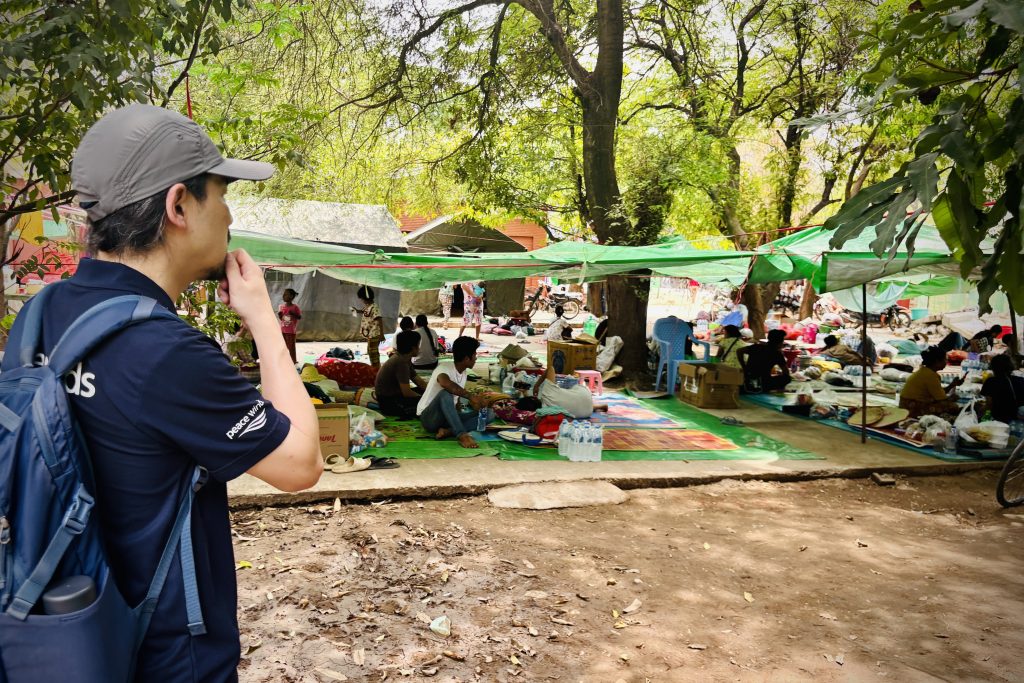「Myanmar」 Supporting Survivors with Medical and Material Aid
A PeaceWinds coordinator, experienced in disaster zones worldwide, couldn’t help but murmur, “Thirteen days after the quake, and people are still living like this…” At a temple in Sagaing, evacuees crowd under flimsy tarps tied to trees, barely qualifying as tents. Dozens sleep on leisure sheets, with no privacy, enduring nearly two weeks in these conditions.
Heat, Squalls, and Shelter Challenges
While surveying the shelter, a student with two years of Japanese study called out, “Otsukaresama desu!” She pointed to her “home”—a single sheet, a pillow, blankets, and a fan. “I live here with my mom. I just got water, a bento with rice and small sides, snacks, and instant noodles,” she said, showing the bento.
Sleeping on hard ground, many complain of back pain, especially the elderly. With prolonged shelter life expected, improvements are urgent. The looming rainy season adds pressure. Myanmar’s hottest period, with temperatures over 40°C, already burdens survivors, but recent rains bring new challenges. Sudden 15-minute squalls with fierce winds batter the area.
“During the last rain, we fled to the monks’ quarters. Rain makes this place unbearable,” the student shared. Fortunately, 3–4-person tents arrived post-interview, relieving fears of rain-soaked nights. Yet, tents don’t solve everything. Space constraints raise questions: Can all evacuees stay? Are there enough toilets? Can infections be prevented in crowded conditions? Peace Winds is monitoring these issues while assessing mid- to long-term needs.

Building a “Trusted Clinic” with Smiles
The temporary clinic operated by Peace Winds is located next to the evacuation shelter. Dr. Inaba, leading the Myanmar earthquake emergency relief team, emphasizes, “Our support goes beyond medical care.” “As a doctor, medical aid is my primary role, but in a major disaster, medical support alone cannot cover all needs. Safe housing, healthy food, and pathways to rebuild lives—each survivor’s needs vary. As a relief organization, we must look beyond medicine, providing supplies and planning mid- to long-term support, always with heartfelt care.”
Since opening on April 7, the temporary clinic has seen a steady stream of patients daily. Despite lacking electricity or internet, word of the “Japanese clinic” has spread by word of mouth, with up to 30 patients visiting for treatment on some days. More children are visiting the clinic. The “ARROWS” nurses, experienced in disaster relief, aim to create a cheerful environment. They prepare coloring books for kids waiting, decorate medicine bags with cute stickers, and use character-themed binders for consultations.
More children are visiting the clinic. The “ARROWS” nurses, experienced in disaster relief, aim to create a cheerful environment. They prepare coloring books for kids waiting, decorate medicine bags with cute stickers, and use character-themed binders for consultations.
 In this harsh, uncertain environment, these small gestures aim to bring even a bit of joy. Such thoughtfulness may be why survivors come to trust and cherish the clinic.
In this harsh, uncertain environment, these small gestures aim to bring even a bit of joy. Such thoughtfulness may be why survivors come to trust and cherish the clinic.

When the medicine bags brought from Japan ran out, the team quickly made new ones using origami. A driver working with the relief effort pitched in to help.
Myanmar Earthquake Emergency Relief: Donations Needed
Peace Winds is aiding victims of the massive earthquake in Myanmar. Your donations empower our efforts, saving lives and building futures. Please offer heartfelt support to those suffering.
Note: Due to overseas operations, we cannot accept goods donations.





